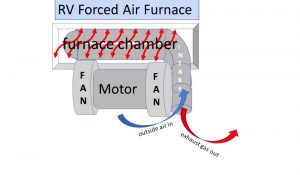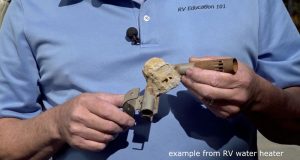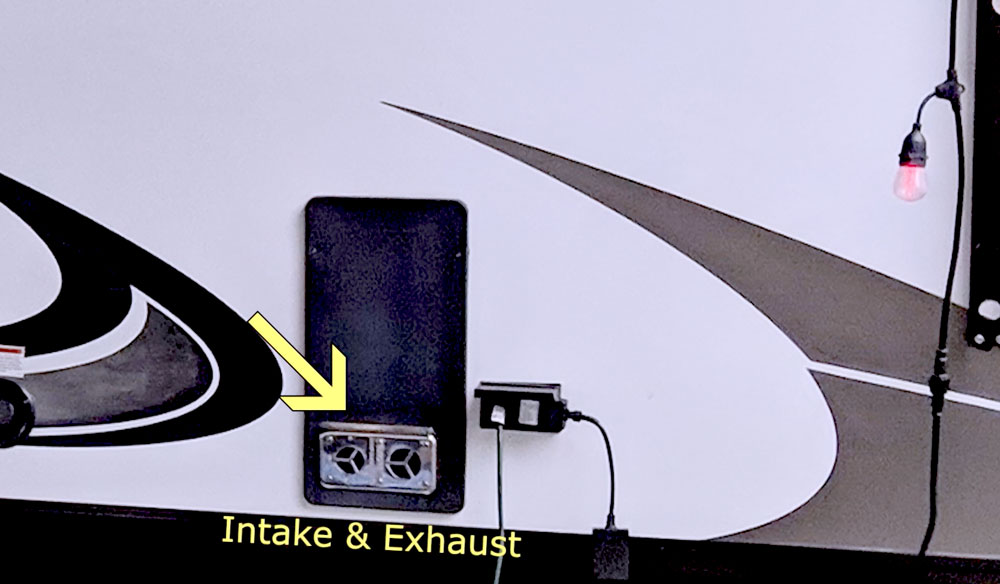Some RV furnaces have two exterior vents like this one, and some have one exhaust vent with the mesh grill for the intake. The RV furnace operates on 12-volt DC power, either from a 12-volt battery or from the RV’s converter when the RV is plugged in to electricity.

The theory of operation for a forced air furnace is a motor using an impeller wheel pulls air from outside for combustion. The exhaust gas created from the combustion of intake air and LP gas is then forced back outside. Internally, there’s another fan that circulates room air across the hot furnace chamber. From there, a blower motor pushes the hot air into the RV’s interior through a network of ducts. When you turn the heat on, the thermostat activates the furnace module board, which in turn starts the furnace blower motor.
Then the module board sends a signal to the gas valve and the direct spark ignition ignites a flame. If the burner lights and everything is operating properly, you will feel heat coming out of the ducts after a few seconds.
What preventive maintenance can RV owners do to ensure reliable and safe operation of the RV furnace? Some quick and easy preventive maintenance owners can do is to inspect the intake and exhaust vents on the furnace. Any type of obstruction in the vents can affect proper combustion. Some insects are attracted to the smell of propane and they build their nest in the RV furnace vents. If you notice any obstructions like this in or around the furnace vents, have it cleaned by an authorized RV service center.
 Next, inspect the exhaust vent for any signs of incomplete combustion. One indication of incomplete combustion is black soot in the exhaust vent. When the vent is not hot, use your finger to check for signs of soot in the vent. Whenever incomplete combustion happens, you can be exposed to dangerous carbon monoxide gas. Do not operate the furnace if you see signs of black soot in the vent until it is checked out by a qualified RV service center. Typical causes for incomplete combustion are obstructions or restrictions in the vents and/or a dirty gas burner. It’s a good idea to have the burner on the furnace cleaned at least once a year and, prior to operating the furnace, inspect the intake and exhaust vents for any obstructions or indications of soot.
Next, inspect the exhaust vent for any signs of incomplete combustion. One indication of incomplete combustion is black soot in the exhaust vent. When the vent is not hot, use your finger to check for signs of soot in the vent. Whenever incomplete combustion happens, you can be exposed to dangerous carbon monoxide gas. Do not operate the furnace if you see signs of black soot in the vent until it is checked out by a qualified RV service center. Typical causes for incomplete combustion are obstructions or restrictions in the vents and/or a dirty gas burner. It’s a good idea to have the burner on the furnace cleaned at least once a year and, prior to operating the furnace, inspect the intake and exhaust vents for any obstructions or indications of soot.
It’s not uncommon for owners not to use the RV for months at a time, so these inspections are important. And remember, if you see indications of black soot, have the furnace inspected by a professional prior to using it. Inspect the return grill for dust, dirt, or obstructions. You can clean the grill using the vacuum cleaner. Make sure nothing is blocking the fresh air return when using the RV furnace.
These are just some basics for maintaining your RV furnace, but always keep in mind if you can catch a problem early through preventive maintenance, it can be less costly to repair and, in the case of the furnace, less dangerous, too.
For more information on using and maintaining your RV, visit rvonlinetraining.com.
To learn more about how to use your RV,
Happy RV Learning,
Mark Polk, your trusted source for RV education




 Next, inspect the exhaust vent for any signs of incomplete combustion. One indication of incomplete combustion is black soot in the exhaust vent. When the vent is not hot, use your finger to check for signs of soot in the vent. Whenever incomplete combustion happens, you can be exposed to dangerous carbon monoxide gas. Do not operate the furnace if you see signs of black soot in the vent until it is checked out by a qualified RV service center. Typical causes for incomplete combustion are obstructions or restrictions in the vents and/or a dirty gas burner. It’s a good idea to have the burner on the furnace cleaned at least once a year and, prior to operating the furnace, inspect the intake and exhaust vents for any obstructions or indications of soot.
Next, inspect the exhaust vent for any signs of incomplete combustion. One indication of incomplete combustion is black soot in the exhaust vent. When the vent is not hot, use your finger to check for signs of soot in the vent. Whenever incomplete combustion happens, you can be exposed to dangerous carbon monoxide gas. Do not operate the furnace if you see signs of black soot in the vent until it is checked out by a qualified RV service center. Typical causes for incomplete combustion are obstructions or restrictions in the vents and/or a dirty gas burner. It’s a good idea to have the burner on the furnace cleaned at least once a year and, prior to operating the furnace, inspect the intake and exhaust vents for any obstructions or indications of soot.